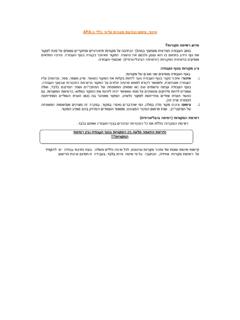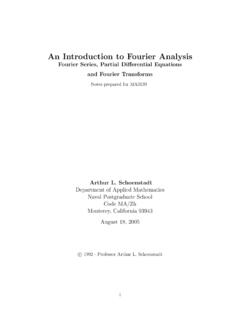Transcription of pET System Manual - BGU
1 PET System Manual TB055 10th Edition 0403 1 United States & Canada 800-207-0144 Germany 0800 6931 000 United Kingdom 0800 622935 Or your local sales office Novagen This second printing of the 10 th edition of the pET Manual was published May, 2003. Novagen is continually expanding and upgrading the pET System . Please check the Novagen website, , for updated pET System Manual information. Table of Contents Table of Contents 1 I. About the System 4 A. Description 4 B. Licensing and Use Agreement 4 C. System Components 4 D. Choosing a pET Vector 5 Primary considerations 5 Solubility and cellular localization 6 Fusion tags 6 pET vector characteristics table 8 E. pET Vector Cloning Strategies 9 Produce native proteins without fusions 9 Produce native proteins without fusions after protease cleavage 10 Ligation-independent cloning 10 F. Regulating Protein Expression in the pET System 11 The T7lac promoter 11 pLysS and pLysE hosts 11 Vector and host combinations affect expression levels 12 Media containing glucose 12 pLacI hosts 13 pETcoco System 13 G.
2 Hosts for Cloning 13 H. Hosts for Expression 14 Protease deficiency 14 Adjustable expression levels throughout all cells in a culture 15 Disulfide bond formation and solubility enhancement 15 Rare codon supplementation 15 Selenomethionine labeling 15 pET System host strain characteristics table 16 I. Antibiotic Resistance 18 J. Bacteriophage CE6 18 K. Induction Controls 19 II. Getting Started 20 A. Overview of The pET System Process 20 B. Growth Media 21 C. Storage of Strains 22 D. Vector Preparation 23 E. Insert Preparation 24 III. Cloning Inserts in pET Vectors 25 A. Ligation 25 B. Transformation 25 Handling tips 26 Procedure 26 Plating techniques 27 C.
3 Analysis of pET Recombinants 28 Transcription/translation analysis with the EcoPro System 28 Plasmid templates 29 PCR templates 29 Ligation PCR for transcription/translation analysis 30 pET System Manual 2 TB055 10th Edition Rev. B 0403 United States & Canada 800-207-0144 Germany 0800 6931 000 United Kingdom 0800 622935 Or your local sales office Novagen Colony PCR for transcription/translation analysis 31 Colony screening 32 Plasmid preparation procedure 32 Sequencing 32 IV. Expressing the Target Gene 33 A. Expression Host Transformation 33 B. Induction of DE3 Lysogens 33 Preparation for induction 33 Sample induction protocol 33 V. Optimizing Expression 34 A. Enhancing Solubility and Folding 34 Temperature 34 Lysis buffer 34 Periplasmic localization 35 Cytoplasmic localization 35 Host strains 36 B.
4 Correcting for Rare Codon Usage 36 C. Toxic Genes and Plasmid Instability 37 Use of ampicillin 37 Supplementing with glucose 38 Plasmid stability test 38 Stabilize a toxic gene in ampR pET vectors for glycerol stock storage 39 Stabilize a toxic gene in ampR pET vectors during induction 39 D. Other Factors Influencing Expression 40 N-end rule 40 Secondary site translation initiation 40 Secondary structure in the mRNA transcript 41 Unexpected stop codons 41 Transcription terminator 41 Instability of the target mRNA and protein 41 VI. Target Protein Verification 42 Normalizing loading volumes for SDS-PAGE 42 Growth and induction 42 Optical density analysis of the induced culture 42 A. PopCulture Quick Screen for Expression Level, Activity and Solubility 43 B. Total Cell Protein (TCP) Fraction 43 C. Medium Fraction 44 D. Periplasmic Fraction 45 E.
5 Soluble Cytoplasmic Fraction 46 BugBuster and Benzonase Nuclease treatment 46 rLysozyme Solution and freeze/thaw treatment 47 Mechnical disruption 48 F. Insoluble Cytoplasmic Fraction 49 Inclusion body purification after BugBuster Reagent treatment 49 Inclusion body purification after mechanical cell lysis 49 G. Preparation of Extracts with PopCulture Reagent 50 VII. Detecting and Quantifying Target Proteins 51 A. Normalized SDS-PAGE Gel Loading 51 B. Detection/Assay Tools for Fusion Tags 52 VIII. Purifying Target Proteins 3 A. Purification Tools 54 B. Solubilization and Refolding 56 IX. Induction Control: -Galactosidase Recombinant 57 -Galactosidase assay 57 X. Acknowledgments 58 pET System Manual TB055 10th Edition 0403 3 United States & Canada 800-207-0144 Germany 0800 6931 000 United Kingdom 0800 622935 Or your local sales office Novagen XI. References 58 XII.
6 Index 61 XIII. Academic and Non-Profit Laboratory Assurance Letter 64 XIV. Bacterial Strain Non-Distribution Agreement 64 XV. Appendix: pET System Host Strains and Lambda Phages 65 DE3 Lysogens for Protein Expression 65 Isogenic Host Strains for Initial Cloning, Controls, and Expression 67 pET Host Strain Competent Cell Sets 68 pET System Lambda Phages 68 2003 Novagen , a brand of EMD Biosciences, Inc., an affiliate of Merck KGaA, Darmstadt, Germany. All rights reserved. * patent pending BetaRed, BugBuster, CBD Tag, ColiRollers, Clonables, Dsb Tag, EcoPro, EKapture, EXlox, FRETW orks, GST Bind, GST Mag, GST Tag, His Bind, His Mag, His Tag, HSV Tag, LumiBlot, Mobius, NovaTaq, NovaTope, Nus Tag, Origami, Pellet Paint, Perfect DNA, Perfect Protein, pETBlue, pETcoco, PopCulture, pSCREEN, RoboPop, Rosetta, RosettaBlue, Rosetta-gami, S Tag, Single Tube Protein, Singles, SpinPrep, STP3, Strandase, T7 Tag, Trail Mix, TriEx, Trx Tag, Tuner, UltraMobius, Xarrest, the Novagen name and logo are trademarks and registered trademarks of Novagen, Inc.
7 Superflow is a trademark of Sterogene Bioseparations Inc. Fractogel and Benzonase are trademarks of Merck KGaA, Darmstadt, Germany. MagPrep is a trademark of EM Industries Inc. CBIND is a trademark of CBD Technologies, Inc. Triton is a trademark of Rohm and Haas Co. Bacto is a trademark of Difco, Inc. The pET System is covered by Patent no. 4,952,496. A non-distribution agreement accompanies the products. Commercial customers must obtain a license agreement from Brookhaven Science Associates before purchase. The pET-32 vectors are sold under patent license from Genetics Institute, Inc. For research use only. Licenses for commercial manufacture or use may be obtained directly from Genetics Institute, Inc., 87 Cambridge Park Drive, Cambridge, MA 02140. The CBD Tag technology is covered under Patent nos. 5,496,934; 5,202,247; 5,340,731; and 5,137,819. Use of this technology for commercial purposes requires a license from CBD Technologies, Inc.
8 Ni-NTA His Bind Resins are manufactured by QIAGEN GmbH. His Tag Monoclonal Antibody is covered under German Patent No. DE 19 507 166 and international patent applications are filed under W09626963 and is provided only for use in research. Information about licenses for commercial use is available from QIAGEN GmbH, Max-Volmer-Str-4, D-40724 Hilden, Germany. The GST Tag technology is covered under Patent no. 5,654,176, European Patent No. 293,249B1, and Australian Patent No. 607,511. Vectors containing the His Tag sequence are licensed under U. S. Patent Nos. 5,310,663; 5,284,933; and European Patent No. 282,042 issued to Hoffmann-La Roche, Inc., Nutley NJ and/or Hoffmann-La Roche Ltd., Basel, Switzerland and are provided only for use in research. Information about licenses for commercial use is available from QIAGEN GmbH, Max-Volmer-Str. 4, D 40724 Hilden, Germany. The His Tag Antibody is covered by patent DE 195 07 166 and international patent applications are filed under W09626963 and is provided only for use in research.
9 Information about licenses for commercial use is available from QIAGEN GmbH, Max-Volmer-Str-4, D-40724 Hilden, Germany. NovaTaq and KOD DNA Polymerases are sold under licensing arrangements with F. Hoffmann La-Roche Ltd., Roche Molecular Systems, Inc. and PE Corporation. KOD DNA Polymerases are manufactured by TOYOBO and distributed by Novagen, Inc. KOD products are not available through Novagen in Japan. KOD XL DNA Polymerase is licensed under Patent No. 5,436,149 owned by Takara Shuzo, Co., Ltd. Purchase of KOD or NovaTaq DNA Polymerases is accompanied by a limited license to use it in the Polymerase Chain Reaction (PCR) process in conjunction with a thermal cycler whose use in the automated performance of the PCR process is covered by the up-front license fee, either by payment to Applied Biosystems or as purchased, , an authorized thermal cycler. All Novagen products are sold for research use only Section I, About the System pET System Manual 4 TB055 10th Edition Rev.
10 B 0403 United States & Canada 800-207-0144 Germany 0800 6931 000 United Kingdom 0800 622935 Or your local sales office Novagen I. About the System A. Description The pET System is the most powerful System yet developed for the cloning and expression of recombinant proteins in E. coli. Target genes are cloned in pET plasmids under control of strong bacteriophage T7 transcription and (optionally) translation signals; expression is induced by providing a source of T7 RNA polymerase in the host cell. T7 RNA polymerase is so selective and active that, when fully induced, almost all of the cell s resources are converted to target gene expression; the desired product can comprise more than 50% of the total cell protein a few hours after induction. Although this System is extremely powerful, it is also possible to attenuate expression levels simply by lowering the concentration of inducer. Decreasing the expression level may enhance the soluble yield of some target proteins.







